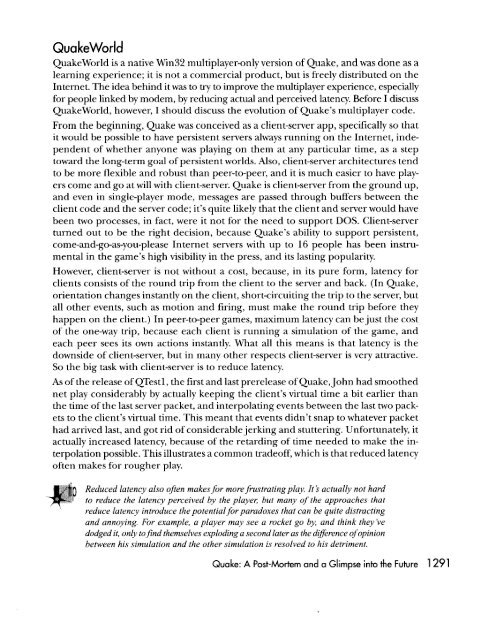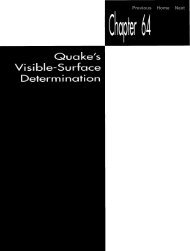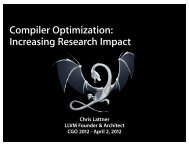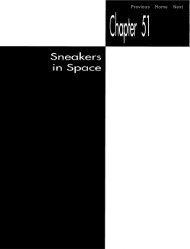quake: a post-mortem and a glimpse into the future
quake: a post-mortem and a glimpse into the future
quake: a post-mortem and a glimpse into the future
You also want an ePaper? Increase the reach of your titles
YUMPU automatically turns print PDFs into web optimized ePapers that Google loves.
Qua keWorld<br />
Quakeworld is a native Win32 multiplayer-only version of Quake, <strong>and</strong> was done as a<br />
learning experience; it is not a commercial product, but is freely distributed on <strong>the</strong><br />
Internet. The idea behind it was to try to improve <strong>the</strong> multiplayer experience, especially<br />
for people linked by modem, by reducing actual <strong>and</strong> perceived latency. Before I discuss<br />
Quakeworld, however, I should discuss <strong>the</strong> evolution of Quake’s multiplayer code.<br />
From <strong>the</strong> beginning, Quake was conceived as a client-server app, specifically so that<br />
it would be possible to have persistent servers always running on <strong>the</strong> Internet, independent<br />
of whe<strong>the</strong>r anyone was playing on <strong>the</strong>m at any particular time, as a step<br />
toward <strong>the</strong> long-term goal of persistent worlds. Also, client-server architectures tend<br />
to be more flexible <strong>and</strong> robust than peer-to-peer, <strong>and</strong> it is much easier to have players<br />
come <strong>and</strong> go will at with client-server. Quake is client-server from <strong>the</strong> ground up,<br />
<strong>and</strong> even in single-player mode, messages are passed through buffers between <strong>the</strong><br />
client code <strong>and</strong> <strong>the</strong> server code; it’s quite likely that <strong>the</strong> client <strong>and</strong> server would have<br />
been two processes, in fact, were it not for <strong>the</strong> need to support DOS. Client-server<br />
turned out to be <strong>the</strong> right decision, because Quake’s ability to support persistent,<br />
come-<strong>and</strong>-go-as-you-please Internet servers with up to 16 people has been instrumental<br />
in <strong>the</strong> game’s high visibility in <strong>the</strong> press, <strong>and</strong> its lasting popularity.<br />
However, client-server is not without a cost, because, in its pure form, latency for<br />
clients consists of <strong>the</strong> round trip from <strong>the</strong> client to <strong>the</strong> server <strong>and</strong> back. (In Quake,<br />
orientation changes instantly on <strong>the</strong> client, short-circuiting <strong>the</strong> trip to <strong>the</strong> server, but<br />
all o<strong>the</strong>r events, such as motion <strong>and</strong> firing, must make <strong>the</strong> round trip before <strong>the</strong>y<br />
happen on <strong>the</strong> client.) In peer-to-peer games, maximum latency can be just <strong>the</strong> cost<br />
of <strong>the</strong> one-way trip, because each client is running a simulation of <strong>the</strong> game, <strong>and</strong><br />
each peer sees its own actions instantly. What all this means is that latency is <strong>the</strong><br />
downside of client-server, but in many o<strong>the</strong>r respects client-server is very attractive.<br />
So <strong>the</strong> big task with client-server is to reduce latency.<br />
As of <strong>the</strong> release of QTestl, <strong>the</strong> first <strong>and</strong> last prerelease of Quake, John had smoo<strong>the</strong>d<br />
net play considerably by actually keeping <strong>the</strong> client’s virtual time a bit earlier than<br />
<strong>the</strong> time of <strong>the</strong> last server packet, <strong>and</strong> interpolating events between <strong>the</strong> last two packets<br />
to <strong>the</strong> client’s virtual time. This meant that events didn’t snap to whatever packet<br />
had arrived last, <strong>and</strong> got rid of considerable jerking <strong>and</strong> stuttering. Unfortunately, it<br />
actually increased latency, because of <strong>the</strong> retarding of time needed to make <strong>the</strong> interpolation<br />
possible. This illustrates a common tradeoff, which is that reduced latency<br />
often makes for rougher play.<br />
p<br />
Reduced latency also ofen makes for more frustrating play. It’s actually not hard<br />
to reduce <strong>the</strong> latency perceived by <strong>the</strong> player, but many of <strong>the</strong> approaches that<br />
reduce latency introduce <strong>the</strong> potential for paradoxes that can be quite distracting<br />
<strong>and</strong> annoying. For example, a player may see a rocket go by, <strong>and</strong> think <strong>the</strong>y’ve<br />
dodged it, only toJind <strong>the</strong>mselves exploding a second later as <strong>the</strong> d@erence of opinion<br />
between his simulation <strong>and</strong> <strong>the</strong> o<strong>the</strong>r simulation is resolved to his detriment.<br />
Quake: A Post-Mortem <strong>and</strong> a Glimpse <strong>into</strong> <strong>the</strong> Future 1291

















